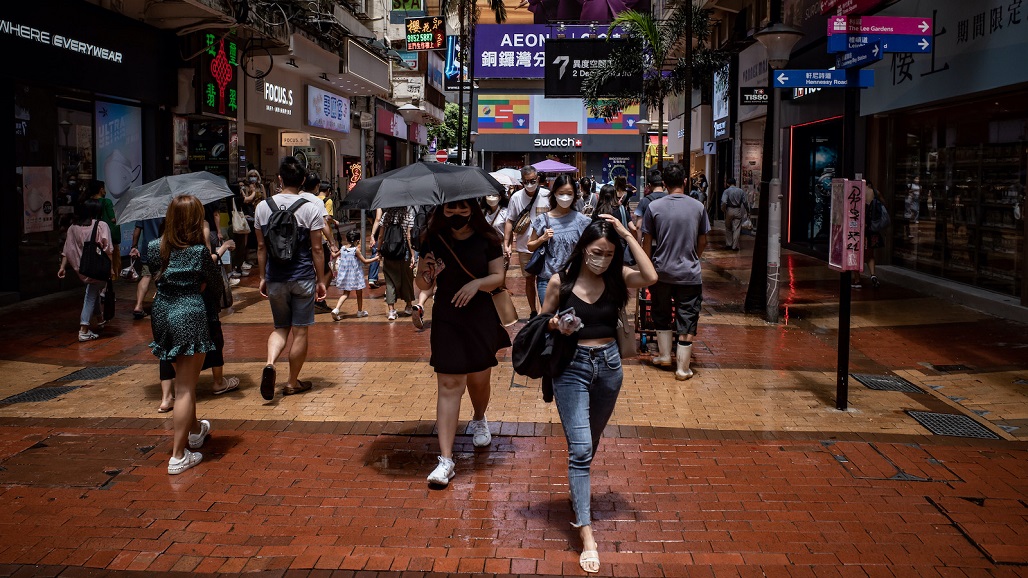Pedestrians walk at a shopping district on August 06, 2022 in Hong Kong, China. Hong Kong’s economy contracted consecutively for the last two quarters in a row due to weak exports and investment as it struggles with pandemic-induced restrictions.
Photo by Anthony Kwan/Getty Images
 China’s economy has shown signs of weakening since April after a respectful first quarter outcome, when GDP grew by 4.8% year on year. The country’s GDP expanded by just 0.4% in the second quarter, due to factors including COVID-related lockdowns in major cities and deterioration in the real estate sector.
China’s economy has shown signs of weakening since April after a respectful first quarter outcome, when GDP grew by 4.8% year on year. The country’s GDP expanded by just 0.4% in the second quarter, due to factors including COVID-related lockdowns in major cities and deterioration in the real estate sector.
Last month, the central bank, People’s Bank of China (PBoC), surprised the market with a significant interest cut: both the one-year medium-term loan facility (MLF) and the seven-day Reverse Repo were lowered by 10 basis points. Another rate cut took place a week later, when the five-year and the one-year loan prime rate (LPR) were each slashed by 15 and 5 basis points.
Restoring Business Confidence Is the Key Objective
China’s recent rate cut was unexpected by most analysts since major central banks around the world have been in a cycle of interest rate hikes in recent months, and China’s consumer price index rose by 2.7% year on year in July, indicating stronger inflation pressure. The market expected the central bank to favor structural monetary tools, such as additional liquidity or rate cuts for selected sectors, rather than a more general interest rate reduction.
We believe the rate cut is reasonable, as it helps to restore business confidence after the release of discouraging macro data for July. Total societal financing (i.e., total excluding financial institutions) experienced a 30% drop year on year, from 1.08 trillion to 756 billion yuan ($108 billion), a new monthly record low in six years.
This implies that willingness and actual borrowing remain weak despite the money authority’s previous policy efforts.
Growing Mortgage Boycotts
Another sign of economic trouble is a fast spread of mortgage boycotts in July, involving projects in 26 provinces and municipalities, raising fear of possible broad risk in the financial sector.
In July, China’s home prices fell for the 11th month and since the breakout of the mortgage strike, the decline has further widened. The rate cut served as a strong policy support for the troubled real estate sector.
Meanwhile, the central bank maintained its prudent stand in liquidity expansion, while taking measures to reduce financing costs for households and companies. On August 15, when 600 billion yuan worth ($86 million) of MLF loans matured, PBoC’s operation had resulted in a net fund withdrawal of 200 billion yuan from the banking system.
A Decline in Borrowing Activity
Underlying the weakness in social financing are inadequate demand for investment and consumption, resulting from uncertainties in enterprises’ profits and the population’s income prospects.
In July 2022, M2, a broad measure of money supply, declined by 337 billion renminbi ($48 billion) month-on-month, compared to an average increase of 3.3 trillion renminbi for the first half of the year. The reductions in new loans, by households and firms, is the most important reason for the decline in M2 balance.
Meanwhile, the risk is increasing that the funds and liquidity are idling within the financial system, due to deterioration of credit demand from the real estate sector. The short-term bill financing of the four state-owned banks and national large banks rose by 148.0% and 102.7% year on year in July 2022, while the growth rate of short-term and long-term loans from these banks declined. In the same month, the growth of loans has also significantly softened (negative) for the small and medium banks, indicating further weakening of credit demand by small- and medium-sized enterprises.
The fiscal injection from the central bank’s profit submission will be depleted soon, and the quota for local government bond issuance will be used up shortly.
Lowering Borrowing Cost and More Targeted Support to Continue
We expect the central bank to accelerate the implementation of existing structural policies, such as extra liquidity to specific sectors, increased targeted credit expansion for SMEs, especially low-carbon and agriculture-related and technological innovation-oriented ones.
For example, the executive meeting of the State Council in June decided for the first time to set 300 billion yuan ($43 billion) aside for policy-based development financial instruments (PDFI) to accelerate funding for local government projects. In August, the government announced a credit increase of 800 billion yuan to policy banks to support infrastructure construction. Another increase of more than 300 billion yuan was added later in the month.
China’s monetary policy will likely continue to aim at stimulating borrowing demand and helping financial institutions to expand credit supply to targeted borrowers.
Funding Support for Local Governments
In March 2022, the PboC announced the PBoC will turn over profits of over 1.1 trillion renminbi to the central government. The amount will be used to accelerate policy implementation including the VAT rebate and other expansionary fiscal policies. In the first half of 2022, it had turned over 900 billion renminbi ($129 billion), equivalent to a liquidity injection from a 0.45 percentage point reduction in reserve requirement ratio, according to PBoC’s estimation.
The profits handed over by the central bank can reach the intended parties directly without going through the traditional money-creation cycle. More importantly, the injection helps to replenish local government finance without raising their debt level, enabling local governments to carry out tax-cutting and employment protection policies and adding the much-needed cash flow into the real sector.
One recent innovation is the use of PDFI (policy-based and developmental financing instruments), a new monetary policy tool first announced in June, which aims to provide quick financing for government-supported infrastructure projects. In particular, PDFI provides start-up or bridging funds through infrastructure funds, which can be considerably faster than the issuance of local government bonds.
At present, PDFI focuses mainly on network-based infrastructure construction for transportation, energy, and irrigation while other local projects such as those on scientific and technological innovation were expected to be funded by local government special bonds.
In the coming months, the government has to come up with more funding to help reverse the economic downturn in recent months. The fiscal injection from the central bank’s profit submission will be depleted soon, and the quota for local government bond issuance will be used up shortly.
The impact of the rate cut has not yet materialized, and the financial risks associated with a depressed real estate sector are far from being resolved. We expect that more monetary easing measures will be announced, especially those targeted to strengthen fiscal expansion for the remainder of the year.
Related themes: CHINA INFLATION
 Sarah Y. Tong
Sarah Y. Tong
Senior Research Fellow at the National University of Singapore
Sarah Y. Tong is a senior research fellow at the East Asian Institute at the National University of Singapore. She holds a Ph.D. in economics from the University of California at San Diego.
Is President Xi’s Dual Circulation Strategy for China Under Threat?
How Much Will the Chinese Economy Be Damaged by COVID-19?
 Li Yao
Li Yao
Research Fellow at the National University of Singapore
Li Yao is a research fellow at the East Asian Institute at the National University of Singapore. She holds a Ph.D. in economics from the University of Hawaii at Manoa.
How Much Will the Chinese Economy Be Damaged by COVID-19?
The original report can be read at the Brink’s website HERE.


Leave a Reply